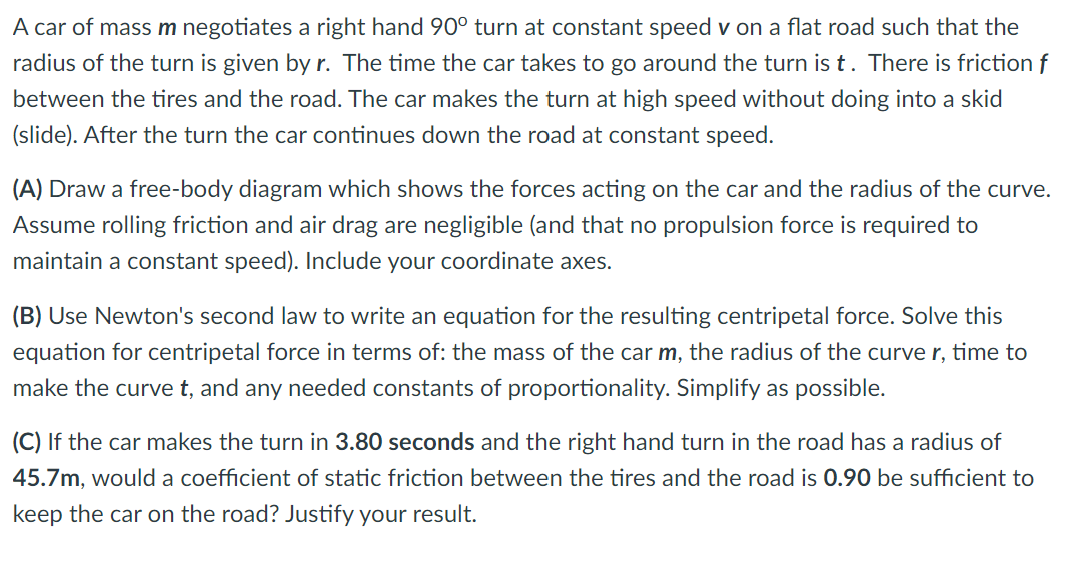A car of mass m negotiates a right hand 90° turn at constant speed v on a flat road such that the adius of the turn is given by r. The time the car takes to go around the turn is t. There is friction f between the tires and the road. The car makes the turn at high speed without doing into a skid slide). After the turn the car continues down the road at constant speed. A) Draw a free-body diagram which shows the forces acting on the car and the radius of the curve. Assume rolling friction and air drag are negligible (and that no propulsion force is required to maintain a constant speed). Include your coordinate axes. B) Use Newton's second law to write an equation for the resulting centripetal force. Solve this equation for centripetal force in terms of: the mass of the car m, the radius of the curve r, time to make the curve t, and any needed constants of proportionality. Simplify as possible. C) If the car makes the turn in 3.80 seconds and the right hand turn in the road has a radius of 45.7m, would a coefficient of static friction between the tires and the road is 0.90 be sufficient to keep the car on the road? Justify your result.
A car of mass m negotiates a right hand 90° turn at constant speed v on a flat road such that the adius of the turn is given by r. The time the car takes to go around the turn is t. There is friction f between the tires and the road. The car makes the turn at high speed without doing into a skid slide). After the turn the car continues down the road at constant speed. A) Draw a free-body diagram which shows the forces acting on the car and the radius of the curve. Assume rolling friction and air drag are negligible (and that no propulsion force is required to maintain a constant speed). Include your coordinate axes. B) Use Newton's second law to write an equation for the resulting centripetal force. Solve this equation for centripetal force in terms of: the mass of the car m, the radius of the curve r, time to make the curve t, and any needed constants of proportionality. Simplify as possible. C) If the car makes the turn in 3.80 seconds and the right hand turn in the road has a radius of 45.7m, would a coefficient of static friction between the tires and the road is 0.90 be sufficient to keep the car on the road? Justify your result.
University Physics Volume 1
18th Edition
ISBN:9781938168277
Author:William Moebs, Samuel J. Ling, Jeff Sanny
Publisher:William Moebs, Samuel J. Ling, Jeff Sanny
Chapter6: Applications Of Newton's Laws
Section: Chapter Questions
Problem 77P: A car rounds an unbanked curve of radius 65 m. If the coefficient of static friction between the...
Related questions
Topic Video
Question
PLEASE ANSWER ALL PARTS ASAP!!!!!!!

Transcribed Image Text:A car of mass m negotiates a right hand 90° turn at constant speed v on a flat road such that the
radius of the turn is given by r. The time the car takes to go around the turn is t. There is friction f
between the tires and the road. The car makes the turn at high speed without doing into a skid
(slide). After the turn the car continues down the road at constant speed.
(A) Draw a free-body diagram which shows the forces acting on the car and the radius of the curve.
Assume rolling friction and air drag are negligible (and that no propulsion force is required to
maintain a constant speed). Include your coordinate axes.
(B) Use Newton's second law to write an equation for the resulting centripetal force. Solve this
equation for centripetal force in terms of: the mass of the car m, the radius of the curve r, time to
make the curve t, and any needed constants of proportionality. Simplify as possible.
(C) If the car makes the turn in 3.80 seconds and the right hand turn in the road has a radius of
45.7m, would a coefficient of static friction between the tires and the road is 0.90 be sufficient to
keep the car on the road? Justify your result.
Expert Solution
This question has been solved!
Explore an expertly crafted, step-by-step solution for a thorough understanding of key concepts.
Step by step
Solved in 2 steps with 2 images

Knowledge Booster
Learn more about
Need a deep-dive on the concept behind this application? Look no further. Learn more about this topic, physics and related others by exploring similar questions and additional content below.Recommended textbooks for you

University Physics Volume 1
Physics
ISBN:
9781938168277
Author:
William Moebs, Samuel J. Ling, Jeff Sanny
Publisher:
OpenStax - Rice University

University Physics Volume 1
Physics
ISBN:
9781938168277
Author:
William Moebs, Samuel J. Ling, Jeff Sanny
Publisher:
OpenStax - Rice University